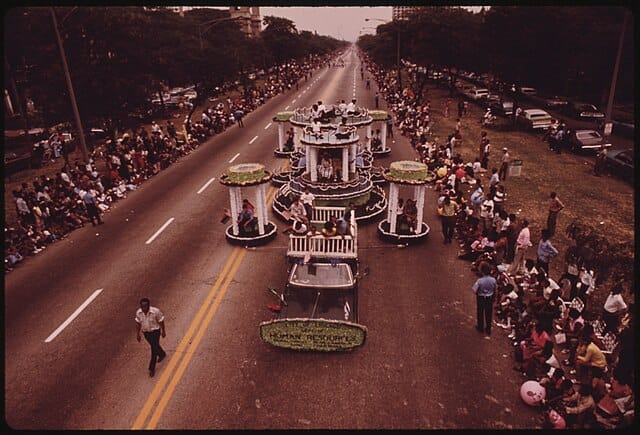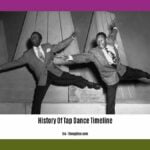The Bud Billiken Parade, a vibrant tapestry of music, dance, and community spirit, has graced the streets of Chicago for nearly a century. More than just a parade, it stands as a powerful testament to African-American resilience, a celebration of youth, and an unofficial kickoff to the school year. Journey with us as we uncover the rich history of this iconic event, exploring its humble beginnings, its evolution over time, and its enduring significance in the heart of Chicago.
History of the Bud Billiken Parade
The year was 1929. The Great Depression had cast a long shadow over the nation, hitting African-American communities particularly hard. In the midst of these challenging times, Robert S. Abbott, the visionary founder of the renowned Chicago Defender newspaper, introduced a beacon of hope: Bud Billiken.
Bud Billiken wasn’t a real person, but a fictional character crafted to inspire and uplift. He embodied the spirit of youth, resilience, and the promise of a brighter future. David Kellum, a writer for the Chicago Defender, envisioned a grand celebration to bring this character to life and unite Chicago’s Black youth. Thus, the Bud Billiken Parade was born.
From its inception, the parade pulsated with energy and pride. It started on King Drive, the heart of Bronzeville, Chicago’s vibrant African-American cultural hub, and culminated in Washington Park with a joyous festival. Marching bands ignited the streets with their infectious rhythms, dance troupes captivated onlookers with their intricate moves, and prominent figures, from community leaders to politicians, waved from brightly decorated floats.
Over time, the parade evolved, mirroring the changing landscape of Chicago itself. While its core mission of celebrating African-American heritage remained constant, it also embraced its role as a back-to-school tradition, a final hurrah before the start of a new academic year.
Today, the Bud Billiken Parade stands as a testament to the power of community, a celebration of Black excellence, and a vibrant reminder that hope and joy can flourish even in the face of adversity. It’s a tradition that continues to inspire, uplift, and unite generations.
What does Bud Billiken stand for?
The story of Bud Billiken is intertwined with the history of the Chicago Defender, a newspaper that played a pivotal role in advocating for African-American rights and amplifying their voices. In 1923, Robert Sengstacke Abbott, the driving force behind the Defender, sought to create a special section dedicated to young readers. Legend has it that while dining at a Chinese restaurant, his eyes fell upon a Billiken figurine, a charm believed to bring good luck. The name resonated with him, and Bud Billiken, the guardian angel of children, was born.
This fictional character, infused with a spirit of optimism and possibility, quickly became a beloved figure within the community. Six years later, the name “Bud Billiken” transcended the pages of the newspaper and took to the streets with the inaugural parade. This wasn’t just a parade; it was a powerful symbol of unity and cultural pride, a vibrant display of the energy and potential of African-American youth.
The parade’s message of empowerment resonated deeply, attracting millions over the years. It became a platform to showcase the community’s talents, celebrate their achievements, and inspire future generations. The Bud Billiken Parade, through its enduring legacy, continues to remind the world of the strength, resilience, and vibrant spirit of the African-American community.
What is the largest African American parade in the United States?
Many might assume the largest African-American parade would grace the streets of cities like Atlanta or New York City, but it’s actually Chicago that boasts this honor. Since 1929, the Bud Billiken Parade has painted the city with a kaleidoscope of colors, music, and jubilant celebration.
While it’s easy to get swept up in the energy of the marching bands, dazzling floats, and energetic dancers, the Bud Billiken Parade represents something far greater than just a spectacle. It’s a powerful symbol of unity, a vibrant tapestry woven from the threads of African-American history, heritage, and aspirations. For almost a century, it has served as a platform to celebrate achievements, to amplify voices, and to showcase the immense talent and creativity within the community.
The parade’s timing, just before the start of the school year, adds another layer of significance. It’s a giant back-to-school bash, a last hurrah before hitting the books, and for many, it marks the “unofficial” end of summer in Chicago.
But the Bud Billiken Parade’s impact extends far beyond its celebratory atmosphere. The organizers, committed to empowering future generations, use the event to raise funds for college scholarships, investing in the dreams and aspirations of countless young people.
The Bud Billiken Parade embodies the spirit of Chicago’s South Side: a vibrant blend of energy, community, and unwavering hope. It’s a testament to the power of collective celebration and a reminder that when a community unites, extraordinary things can happen.
What is the biggest parade in Chicago?
Chicago, a city renowned for its vibrant spirit and grand celebrations, hosts numerous parades throughout the year. But when it comes to sheer scale and cultural significance, the Bud Billiken Parade reigns supreme. Not only is it Chicago’s biggest parade, it proudly holds the title of the largest African-American parade in the entire United States!
Imagine a sea of over a million spectators lining the streets, their cheers echoing to the rhythm of over 200 marching bands. Picture a dazzling procession of more than 100 elaborately designed floats, each one a testament to creativity and community spirit. This is the Bud Billiken Parade, a celebration of youth, culture, and the boundless energy of Chicago’s South Side.
The parade’s origins can be traced back to 1929, a brainchild of Chicago Defender reporter David Kellum. He named it after Bud Billiken, a fictional character dreamt up by Robert S. Abbott, the newspaper’s founder.
The Bud Billiken Parade has become more than just a parade; it’s a cultural phenomenon, a vibrant tapestry woven from the threads of history, music, and community spirit. It’s a testament to the power of celebration and a reminder that some traditions, like the spirit of Chicago itself, only grow stronger with time.
Was there a shooting at the Bud Billiken Parade?
For 85 years, the Bud Billiken Parade unfolded as a day of unadulterated joy, a testament to the strength and unity of the African-American community. Sadly, in 2014, this cherished tradition was marred by an act of violence that shook the city. On August 9th, a dispute erupted, and shots rang out near the parade route. An 18-year old lost his life, casting a shadow of grief over the festivities.
This incident sent shockwaves through Chicago. It was a stark reminder that even amidst celebrations of hope and resilience, the city was grappling with the pervasive issue of gun violence. The shooting sparked fear and outrage, leaving many questioning how such a tragedy could touch an event that represented so much good.
The immediate response was swift. Law enforcement agencies, determined to prevent future incidents, bolstered security measures for subsequent parades. The organizers, deeply saddened by the tragedy, remained resolute in their commitment to the parade’s message of unity and hope.
The community, too, refused to let this act of violence define their beloved tradition. The following year, the Bud Billiken Parade returned, its spirit undeterred. The music played on, the dancers danced, and the people came out in droves, demonstrating their unwavering resilience and their refusal to let fear overshadow their celebration.
The 2014 shooting serves as a solemn reminder of the complexities that cities like Chicago face. Yet, the Bud Billiken Parade’s enduring legacy stands as a testament to the power of community, the resilience of the human spirit, and the unwavering belief in a brighter future.
What is the story of Bud Billiken?
In 1923, Chicago’s South Side witnessed the birth of a hero – not in a blaze of glory, but within the pages of the Chicago Defender, a newspaper that served as a beacon of hope and a voice for the African-American community. This hero wasn’t a caped crusader; he was Bud Billiken, a fictional character brimming with optimism and a mischievous grin.
While the exact inspiration behind Bud Billiken remains shrouded in mystery, his impact was immediate and profound. He symbolized hope during a time when the community faced significant hardships, embodying the potential of youth and the promise of a brighter future. He was a reminder that even in the face of adversity, joy and resilience could prevail.
In 1929, the Chicago Defender decided to bring their beloved character to life, transforming him from a newspaper icon into a symbol of community celebration. The inaugural Bud Billiken Parade was a resounding success, a testament to the power of collective joy and a celebration of everything that made the African-American community so vibrant.
The parade, named in honor of this fictional guardian angel, became a platform for young people to showcase their talents, for local heroes to be recognized, and for the entire community to unite under a banner of shared pride. The legacy of Bud Billiken, the fictional character, extended far beyond the printed page; it became intertwined with the spirit of the parade itself, representing the dreams, aspirations, and enduring spirit of a community.
What is the story of the Billiken?
The story of the Billiken is a journey that spans continents, intertwining dreams, football, and a touch of international intrigue. Our tale begins in 1908 with Florence Pretz, an art teacher from Missouri, who claimed to have dreamt up this whimsical figure. Some speculate that she drew inspiration from the popular children’s book illustrations of the time, but the exact genesis of the Billiken remains a mystery.
The Billiken, with his Buddha-like belly, mischievous grin, and air of playful wisdom, quickly captured the hearts of Americans. Around the same time, across the country in St. Louis, a football coach named John Bender was gaining notoriety for his winning smile and, some might say, his resemblance to the Billiken. This uncanny resemblance led to the Billiken being adopted as a good luck charm for St. Louis University’s football team.
What started as a local phenomenon quickly snowballed into a national craze. The Billiken’s image adorned everything from dolls and toys to household items. He became a symbol of good fortune, a reminder to embrace life’s simple joys.
But the Billiken’s journey didn’t end there. In the 1920s, he embarked on a transpacific voyage, captivating the hearts of the Japanese people. The Billiken found a special place in Japanese culture, often appearing in temples and shrines, his belly rubbed for good luck.
The Billiken’s enduring appeal, some experts believe, lies in his ability to transcend cultural boundaries. He embodies a universal yearning for happiness, good fortune, and a touch of lightheartedness. Others suggest his charm lies in his simplicity, a reminder of the pure joy often associated with childhood.
While the Billiken may not command the same level of mainstream attention he once did, his story is a testament to the enduring power of a mascot and the universal appeal of optimism and good cheer. He serves as a whimsical reminder that a little bit of hope and a whole lot of whimsy can go a long way.
What does the Billiken represent?
Florence Pretz unleashed the Billiken upon the world in 1908, envisioning a chubby, bald figure with a mischievous grin and a knowing glint in his eyes. But the question remains: what exactly does this enigmatic figure symbolize?
The Billiken most commonly evokes feelings of good fortune, happiness, and serendipity. Even the name itself, believed to be derived from the Japanese phrase “mi-roku,” meaning “beautiful coming,” hints at a sense of auspiciousness.
He’s often depicted with a playful smile, a tuft of hair crowning his head, and his hands clasped over his belly as if harboring a secret or perhaps embodying contentment. While the Billiken’s precise meaning remains open to interpretation, there are a few prevailing theories that attempt to unravel his enigmatic nature.
Some believe the Billiken encourages us to embrace the unexpected, to find joy in the simple things, and to navigate life’s twists and turns with a sense of playful acceptance. Others see him as a symbol of resilience and optimism, a reminder to maintain a positive outlook even when faced with challenges.
Ultimately, the Billiken’s message may be as multifaceted as the people who encounter him. Perhaps his greatest gift is his ability to elicit a smile, to infuse our lives with a touch of whimsy, and to remind us that sometimes, a little bit of lightheartedness can make all the difference.
How did the Billikens get their name?
The year is 1908. Florence Pretz, an art teacher from Missouri, experiences a vivid dream, a vision of a curious and whimsical creature. This figment of her imagination, with its mischievous grin and air of good fortune, would soon become known as the Billiken.
But how did such a peculiar name come to be? Legend has it that Pretz stumbled upon a Japanese phrase, “mi-roku,” which roughly translates to “beautiful coming” or “the god of things as they ought to be.” This concept of beauty, serenity, and auspiciousness resonated deeply with her, and the name “Billiken” was born.
It’s fascinating to consider the impact a single word can have. Would this charming mascot have captured the hearts of millions if not for its unique and memorable name? The story of the Billiken’s name reminds us of the unexpected ways in which inspiration can strike and how even a single word can become imbued with meaning and cultural significance.
What does Bud stand for in Budweiser?
“Bud,” the ubiquitous nickname for the iconic American beer Budweiser, isn’t just a shortened version of the name; it’s a direct link to the beer’s origins and brewing heritage. The name “Bud” pays homage to a town in the Czech Republic called Budweis, a place renowned for its centuries-old brewing traditions.
Budweis stands as a testament to the artistry of Bohemian-style lager, a style of brewing that captured the attention of Adolphus Busch, one of the founders of Anheuser-Busch. During a trip to Budweis, Busch was so impressed by the local lagers that he decided to bring a similar taste back to the United States.
Thus, Budweiser was born, not as a mere imitation, but as an homage to the town and the brewing traditions that inspired it. So, the next time you hear someone order a “Bud,” remember that they’re not simply asking for a beer; they’re partaking in a legacy that stretches back centuries and spans continents.
What is the nickname of St. Louis?
St. Louis, a city steeped in history and brimming with character, boasts a collection of nicknames, each one reflecting a different facet of its identity. Let’s delve into some of the most popular monikers and uncover the stories they tell.
- The Lou: Arguably the most widely recognized nickname, “The Lou” rolls off the tongue with a sense of familiarity and endearment. Its rise to mainstream popularity can be attributed in part to rapper Nelly’s hit song “Country Grammar.” Today, “The Lou” has become synonymous with St. Louis’s unique blend of Midwestern charm and urban sophistication.
- Rome of the West: This grand nickname speaks to St. Louis’s architectural heritage and its deep Catholic roots. The city’s skyline is punctuated by majestic churches, none more impressive than the Cathedral Basilica, a testament to architectural grandeur and spiritual devotion.
- Gateway City or Gateway to the West: These nicknames transport us back to the 19th century, a time when St. Louis marked one of the last major urban centers before the vast expanse of the American West. As a bustling hub for trade and transportation, St. Louis became known as the “Gateway to the West,” a launching point for countless pioneers and adventurers seeking new beginnings.
- River City: This nickname requires little explanation. St. Louis sits strategically at the confluence of two mighty rivers: the Missouri and the Mississippi. “River City” speaks to the city’s deep connection to its waterways, evoking images of bustling riverboats, moonlit reflections, and the timeless allure of life on the river.
The abundance of nicknames associated with St. Louis highlights the city’s multifaceted identity. Each moniker offers a glimpse into its history, its culture, and the way it has been perceived throughout time.
Want to learn more about the origins of these nicknames or discover even more aliases for St. Louis? We encourage you to delve deeper and see what other fascinating tidbits you can uncover! After all, exploring the stories behind a city’s names is a fantastic way to understand its character.
Discover the rich history behind the iconic history of the durag and explore its cultural significance. Delve into the history of the crusades podcast to gain insights into the captivating era of religious wars. Uncover the fascinating history of the gideons and their mission to distribute Bibles worldwide.



![[Phrase Match] Embracing Evolution: A Journey Through Contemporary Dance History contemporary-dance-history_2](https://www.lolaapp.com/wp-content/uploads/2023/12/contemporary-dance-history_2-150x150.jpg)












2 thoughts on “A Century of Celebration: Unpacking the Rich History of the Bud Billiken Parade”
Comments are closed.